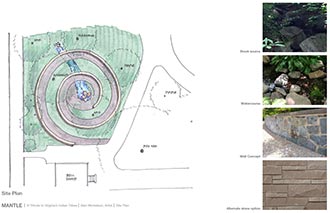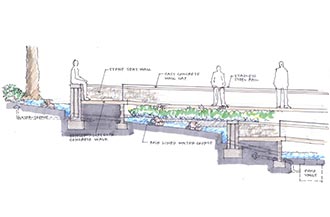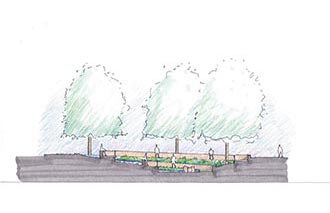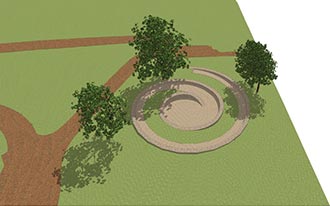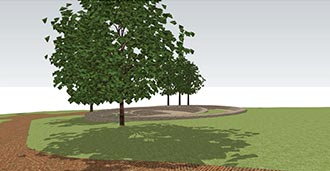Mantle
Virginia Indian Tribute
A monument planned for Capitol Square
Native peoples have lived in this land we know as Virginia, for thousands of years. Despite hardships brought about by the loss of their land, language, and civil rights, many Virginia tribes persisted and their members have continued to contribute to the Commonwealth through agriculture, land stewardship, teaching, military and civic service, the arts, and other avenues.
In recognition of their lasting legacy and significance, as well as to ensure that the rich and inspiring stories of our native peoples will endure, the Virginia Indian Commemorative Commission was established with the purpose of erecting a permanent monument on Capitol Square.
Final Design Presentation (pdf)
The Monument: Mantle
Oriented to the earth and incorporating existing trees in the area, Mantle combines four integrated spiral elements to create the shape of a Nautilus. A five-foot wide winding footpath will follow the outline of the monument; rising from and returning to the earth. In addition to the path will be a continuous, smooth stone wall, which also serves as a bench. Natural landscaping throughout the monument will consist of a selection of perennial native plant species, including wildflowers. A meditation area, at the center of the spiral, will feature an infinity pool made to resemble the pottery indicative of Virginia tribes. The water within the pool reflects the river culture existing within these native tribes. Decorating the sides of the sculpture are frieze-like, life-size reliefs of corn, squash, and beans (the Three Sisters) as well as oyster shells from the Chesapeake and other objects significant to the region and its native inhabitants.
As visitors wend their way through the path their movements will evoke the circular dance formations found in the American Indian* culture. Alan Michelson, a Mohawk member of Six Nations of the Grand River and an award winning artist has been commissioned to create Mantle. Michelson describes the monument saying, "[Mantle] requires the visitor to neither look up nor look down, but invites one to enter—from the east—and participate in it. It is not conceived as a static monument to be venerated but an active one to be experienced by moving off the everyday grid and into the American Indian circle".
Mantle will serve as a meditation space where visitors can either walk the labyrinth or sit and contemplate. It will also be a gathering spot where groups can formally or informally assemble. As a communal area, Mantle creates a respectful relationship with the surrounding natural world, reflecting the positive values, which set the Indians apart from other cultures. Finally, through state-of-the-art educational programs developed in partnership with scholars at the Virginia Foundation for the Humanities, Encyclopedia Virginia and Library of Virginia, Mantle hopes to educate the community by bringing awareness of the history and culture of the Virginia Indians, through a virtual web-based tour similar to one offered at the National Mall in Washington.
In geological terms, the "mantle" represents the layer of the earth between the crust and the outer core. In relation to mollusks, such as the nautilus, it is the layer which secretes the shell. And in ceremonies, a "mantle" takes the form of a garment, symbolizing preeminence and authority. The distinct spiral shape of this monument was chosen specifically from three sources:
- Powhatan's Mantle - a historic deerskin cloak, decorated with shell-beads sewn in spiral clusters, believed to have belonged to the great Indian chief. The designs on the mantle are thought to represent the 34 members of the Powhatan Confederacy and the balance of powers among these Chesapeake tribes.
- Labyrinths - a sacred symbol. Carl Schuster and Edmund Carpenter, in their cross-cultural study of tribal symbols, Patterns that Connect: Social Symbolism in Ancient & Tribal Art, assign various meanings to the labyrinth, including a sacred path to the home of an ancestor, "...many (New World) Indians who make the labyrinth regard it as a sacred symbol, a beneficial ancestor, a deity."
- Nautilus – the nautilus is a living fossil which has been replicating itself for 500 million years, carrying in its chambers the memories and knowledge of times past. The spiral shape of their shells consists of a series of ever-larger chambers, each of which the creature lives in until it outgrows that particular space, moving on to the next one. The shape of the nautilus shell suggests that it can keep growing forever. It is also considered as a symbol for strength, as the shell can withstand very high pressure and a symbol of perfection and beauty, having remained unchanged for centuries. In addition to the symbolism associated with the nautilus, many fossils of this shell can be found throughout the floor of the Capitol building!
Location
The Virginia Indian Commemorative Commission has chosen to place Mantle in the gently sloping southwest portion of the square, just north of the Bell Tower, with an eastern facing entrance. As the "Front Door" of the Commonwealth, historic Capitol Square provides a dramatic setting for Mantle. With its picturesque landscape predating New York's Central Park by over a decade, the Square is also a beautiful architectural and cultural setting for landmark events that have shaped America's people, political institutions, judicial traditions, and social progress. Capitol Square's twelve acres of landscaped grounds provide a first impression to hundreds of thousands of visitors, who enter the Square each year. The historical significance, the majestic setting, and the multitude of visitors, make the Square a premier place to recognize outstanding Virginians and events, including our Virginia Indian tribes.
Estimated cost
$1 million to include all costs associated with the commissioning and installation of Mantle, associated educational programs, and perpetual care for the Monument.
Virginia Capitol Foundation (VCF), a registered 501(c)(3), is working in partnership with the Virginia Indian Commemorative Commission. For more information on Mantle and to express your support of this historic initiative, please contact VCF Executive Director Colleen Dugan Messick, Post Office Box 396, Richmond, Virginia, 23218 or by calling (804) 786-1010 or emailing cmessick@virginiacapitol.gov.
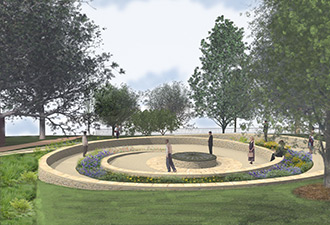
Schematic design of the northeast view of Alan Michelson's Mantle.
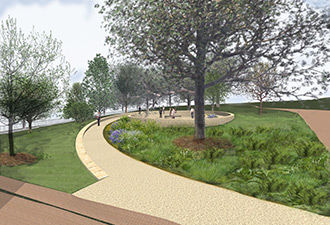
Schematic design of the entry of Mantle.
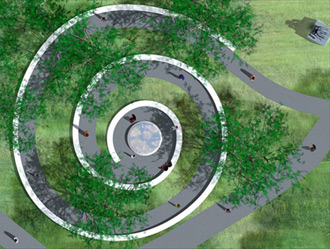
Arial view of Alan Michelson's prototype of Mantle.
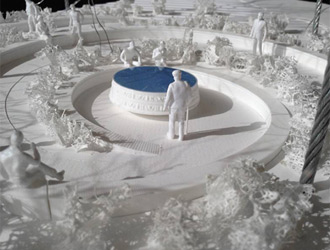
A meditation area, at the center of the spiral, will feature an infinity pool made to resemble the pottery indicative of Virginia tribe.
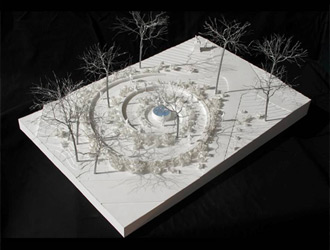
3-D prototype of Mantle.
